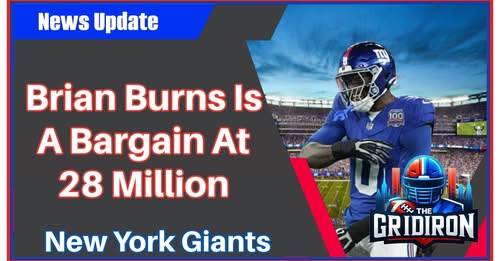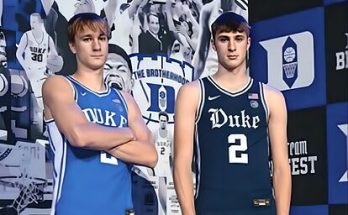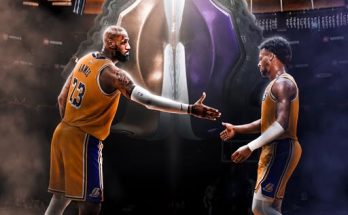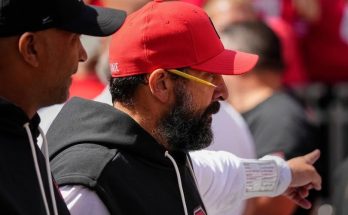When the New York Giants made the move to acquire Brian Burns, eyebrows were raised—not out of doubt but intrigue. How did a player of Burns’ caliber become available at all, let alone for what many analysts now call a “bargain?” In a league where elite edge rushers command immense value, both in cap space and trade capital, the Giants’ acquisition of Burns was not only opportunistic—it may go down as one of the smartest transactions of the 2025 NFL offseason.
What makes the deal even more fascinating is the unexpected and unconventional interest in Brian Burns from programs and franchises outside of the typical NFL circles. Rumors and insider reports have suggested that major college football programs like the Tennessee Volunteers and Alabama Crimson Tide, and even an NBA franchise in the Indiana Pacers, had a type of non-playing interest in Burns as a figurehead, recruiter, or motivational figure. While this doesn’t mean he was close to suiting up for a college game or NBA contest, the multifaceted value Burns offers—his charisma, professionalism, and magnetic presence—is something that’s clearly transcending football. That alone adds to the perception that the Giants got much more than just an edge rusher.
Let’s unpack how this all came together.
Burns, a two-time Pro Bowler and a staple in the Carolina Panthers’ defense since he was drafted in the first round in 2019, had long been one of the more quietly dominant forces in the league. His sack totals, QB pressures, and versatility off the edge were all top-tier, yet he rarely got the national media spotlight due to Carolina’s lack of success during his tenure. The Panthers’ front office appeared to be in a transitional phase, rebuilding from the bottom up after several disappointing seasons. As their roster reshuffled, Burns’ name came up often in trade rumors, yet nothing ever materialized. Teams reportedly inquired, but the asking price was consistently steep—first-round picks, young prospects, or cap room flexibility that many contenders couldn’t afford.
Fast forward to 2025, and the Giants saw a window.
New York had been rebuilding their own defensive identity for years. With Kayvon Thibodeaux on one side and Dexter Lawrence dominating the middle, the Giants just needed one more elite pass rusher to truly transform their front seven. Burns, still only 27 years old, checked all the boxes: experience, production, durability, and scheme versatility. But what no one fully anticipated was the ease with which the Giants landed him. The final trade package was modest relative to expectations—future draft compensation and minimal player movement, allowing the Giants to retain their core while adding an elite defender.
To fully understand why Burns now seems like a bargain, it’s necessary to compare him to his positional peers in both talent and contract value. In the last two seasons alone, multiple edge rushers have signed deals north of \$25 million annually, including Nick Bosa, T.J. Watt, and Myles Garrett. Burns’ new deal, while lucrative, came in slightly below that top echelon, due in part to timing and his willingness to work with the Giants on roster-building flexibility. In a league where quarterback disruption is currency, locking up a 1B to Thibodeaux’s 1A is invaluable.
But what elevates this acquisition into a realm of intrigue is what Burns brings off the field.
Shortly after the trade, stories began circulating about his connections to athletes and coaches in both college and professional sports. The Tennessee Volunteers football program, reportedly, had reached out to Burns in a mentorship capacity. Burns, who played his college ball at Florida State, had maintained close ties to several high school and college players through offseason camps and clinics. Tennessee’s recent surge in recruiting success had partly been attributed to their outreach to NFL veterans who could relate to today’s student-athletes while serving as examples of how discipline and consistency lead to success.
Burns became a recurring presence at Tennessee’s offseason training programs—not as a coach, but as a motivator. His speeches to defensive linemen, particularly about hand technique, pad leverage, and pass-rush angles, were said to be as instructive as any positional coach’s teachings. The Vols wanted more. There were informal talks—never official—about involving Burns in NIL strategy, player development workshops, and offseason boot camps. While contractual NFL obligations ultimately prevented anything formal from forming, the idea that a franchise-level talent was being sought out by a major SEC power for off-field development speaks volumes about Burns’ influence.
The interest from Alabama followed a similar trajectory. Nick Saban may be retired now, but Alabama’s tradition of involving NFL veterans in their ecosystem hasn’t waned. Burns was approached as a potential summer guest speaker and even an offseason training collaborator. Multiple Crimson Tide alumni had trained with Burns in the offseason, and word of his detail-oriented approach reached Tuscaloosa quickly. In a program known for its precision and excellence, Burns was a perfect cultural fit—even from a distance. Alabama wanted its young pass rushers to hear from someone who’d succeeded in the league not just by brute strength but by intelligence and attention to technique.
That kind of interest doesn’t emerge for just any NFL player.
Even more surprisingly, the Indiana Pacers’ name came up. Not in the sense of on-court involvement, but in a holistic, player culture building sense. The Pacers’ front office has embraced a cross-sport approach to athlete development, often bringing in NFL, MLB, and Olympic athletes to speak to their young roster about mindset, professionalism, and managing the highs and lows of a long season. Burns was on their radar after a podcast appearance in which he discussed mental health, preparation, and his journey through football adversity. The Pacers reportedly invited him to an offseason leadership summit, alongside figures from other sports, and had discussed a role in mentoring their younger players, especially given his calm demeanor, team-first attitude, and elite-level consistency.
Now circling back to New York, the Giants benefit from all of this. They didn’t just get a great pass rusher—they got a culture transformer. Burns’ presence in the locker room was almost immediately felt. Coaches raved about his quiet professionalism. Teammates remarked on how his technique in drills elevated everyone around him. Even Thibodeaux, known for his flamboyant charisma and emotional energy, appeared to be feeding off Burns’ steady approach. The defensive line room suddenly had a veteran anchor to balance its youthful dynamism.
The Giants’ defense, which had been middling for years, has already shown signs of cohesion and structure not seen in a long time. Burns’ ability to hold the edge, read offensive line shifts, and collapse the pocket is creating easier assignments for linebackers and safeties alike. This ripple effect is visible in early training camp reports. Rookie linebackers have commented on how much simpler their reads are with Burns and Lawrence commanding double teams. Blitz packages are more deceptive. Quarterbacks are being hurried into throws. And perhaps most importantly, confidence is building.
Burns’ “bargain” status isn’t just about dollars and cents or trade value. It’s about the intangible boost he provides. Teams pay premium prices for leadership, culture stability, and consistency—Burns delivers all three. In a league where locker room chemistry can determine whether a team reaches the playoffs or languishes in mediocrity, adding someone of Burns’ mindset is a calculated win.
It also speaks to general manager Joe Schoen’s evolving reputation. In an era where cap space, draft capital, and locker room psychology are all tightly interwoven, pulling off a trade like this without gutting the team’s future is no small feat. And it didn’t happen in isolation. The Giants have been slowly building a foundation with young, high-character players and thoughtful veteran signings. Burns may very well be the keystone that pulls it all together.
His marketability will also be a long-term benefit. New York is the media capital of the world, and Burns’ poised demeanor and off-field involvement will surely attract endorsements, youth initiatives, and community programs. Expect to see him more often on talk shows, charity events, and youth camps across the tri-state area. The Giants have been starved for a defensive ambassador to rival their offensive icons. Burns might just become that face.
In summary, when you consider Burns’ on-field production, off-field appeal, leadership traits, and the cultural capital he brings from being courted by programs like Tennessee, Alabama, and even an NBA team like the Pacers, it’s fair to say this was more than a football trade—it was a strategic acquisition of a full-spectrum leader. The Giants didn’t just buy sacks and pressures. They bought mentorship, elevation, and legacy-building potential.
And they got it all at a price that now seems laughably low.
That’s the definition of a bargain.



